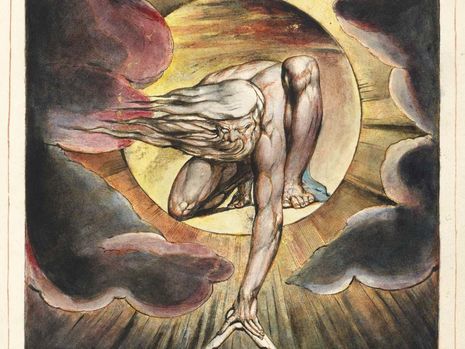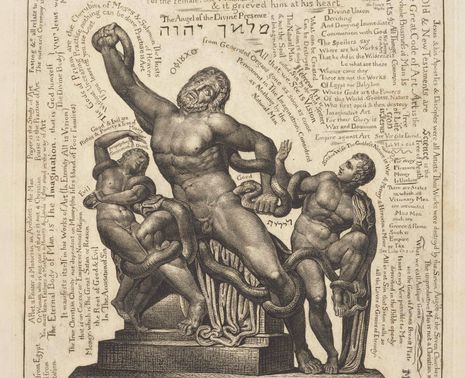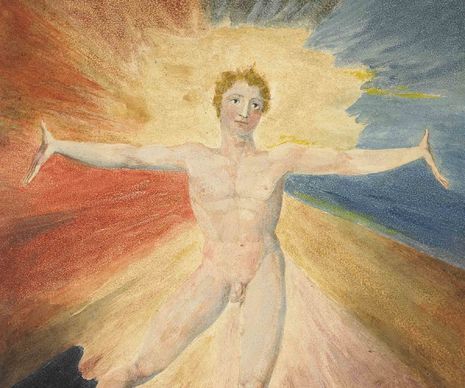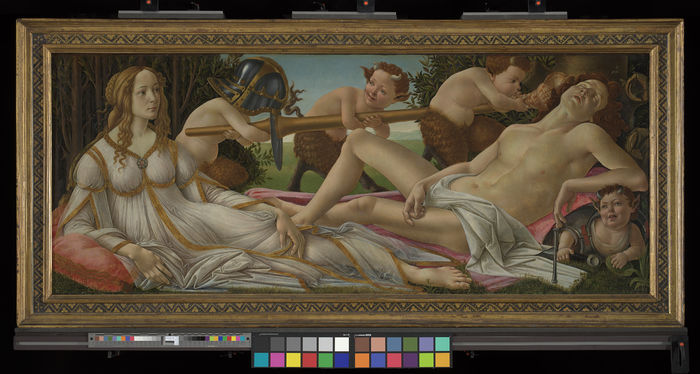William Blake like you’ve never seen before
Ailsa McTernan reviews the Fitzwilliam’s revisionist exhibition of the trailblazing Romantic poet and painter

What first comes to mind when you hear the name William Blake? Perhaps it’s the haunting verses of ‘Jerusalem,’ with its utopian visions of “England’s green and pleasant land”. Or maybe it’s those beautifully illuminated pages of Songs of Innocence and of Experience, only one of a vast corpus of Blake’s contributions to English poetry. Possibly, it’s the artist’s strikingly futuristic visions, which somehow predate H.G. Wells’ The War of the Worlds by a century.
The Fitzwilliam Museum’s newly opened exhibition, ‘William Blake’s Universe’ tells a very different story. Reaching beyond England’s pleasant pastures, Blake’s extraordinarily varied oeuvre is positioned at the centre of a constellation of European ideology and revolution. Here, he is not a lone, spiritualistic ‘visionary’ absorbed in a disconnected vacuum of fantasy, but a culturally engaged artist responding to radical artistic and political currents on the global stage.
“The exhibition’s very design presents a macrocosm of Blake’s ethos”
On entering the exhibition, the viewer is immediately confronted with two portraits: a young, brooding image of German artist Philipp Otto Runge faces a death mask of Blake himself. Encircling this central face-off are intimate portrait drawings of Blake’s artistic circle; a melancholic image of a young Samuel Palmer and a pugnacious self-portrait of Irish artist James Barry stand out among the Romantic line-up. We then step into ‘The Past’ to explore the links between Blake’s drawings and the art of classical antiquity. A figure from ′The Crucifixion of Saint Peter’ by Michelangelo receives a Blakean makeover on the first wall. Now relabelled ‘Joseph of Arimathea among the Rocks of Albion,’ Blake adds dramatised lighting and sets the figure against a romantic seascape. His polemicised and Christianised ‘Laocoön’ on the far wall, standing at the intersection of classical and current, pulls the viewer into the artist’s ‘Present’ universe. Here, we encounter Blake’s impassioned book illustrations for his European and American prophecies, positioned within the flames of political cataclysms. In ‘The Future,’ Blake’s ambitious Jerusalem series (1804-20) contrasts Runge’s fantastical ‘total artwork’ compositions exploring the interrelationship of the natural world and the human soul. The exhibition culminates in an arresting vision of the redeeming ‘Albion Rose’.

This landmark exhibition not only showcases some of Blake’s most celebrated works but presents a rare opportunity to see the trailblazing output of German artists Philipp Otto Runge, Caspar David Friedrich and others. These works have “hardly ever been seen in Britain before”, co-curator David Bindman told me in a recent interview. Friedrich’s poignant drawings, ‘The Ages of Man’ are “rarely let out of Hamburg, and likely will never be let out again.” While it is pity that the exhibition did not manage to include two of Friedrich’s paintings intended to be loaned from Hamburg, this sepia series nevertheless provides an intimate glimpse of the German artist’s profoundly spiritual work.
“These works have hardly ever been seen in Britain before”
“It starts with an idea”, says Bindman. He explains how two German exhibitions on John Flaxman and Blake in the 1970s planted the seed for the Fitzwilliam’s uniquely ‘European’ treatment of Blake’s works almost half a century later. As co-curator Esther Chadwick pointed out at the Press Review event, “‘William Blake the European’ was the original title”. She describes the exhibition’s intentions to complicate the traditional view of Blake as a singularly eccentric artist and emblem of ‘Englishness’, and instead explore the ways in which Blake’s work paralleled those of his Romantic contemporaries.
This show takes a different approach to the Tate’s groundbreaking digitalisation project in 2019, but presents an equally vibrant, stimulating environment for Blake’s prophetic illustrations. As Bindman explains, squeezing Blake’s prolific work into a single space is “not at all easy”. “It requires a great deal of thought”, he says, and calls for “a designer you can really trust” to make it work.

Blake’s ‘Prophecy’ illustrations are ingeniously displayed on a diagonal concertina partition across the third room, reproducing the experience of reading a book. Strategically placed apertures in the walls visually connect works across the space and unite ‘Past’, ‘Present’ and ‘Future’. Chadwick explains that the primary colour-scheme wall design had two-fold motivation; it reflects the tricolour scheme of Blake’s famous hand-coloured ‘Albion Rose’ and at once draws out Runge’s seminal colour theories. The fusion of literary quotes and images in the space encapsulates Blake’s intrinsically intersectional working practice. In the cohesive fusion of space, word and image, the exhibition’s very design presents a macrocosm of Blake and Runge’s ‘total artwork’ ethos.
‘William Blake’s Universe’ offers a chance to consider this groundbreaking British artist in a much wider context. As well as proposing an intricate nexus of artistic ties, the side-by-side comparisons at once unveil Blake’s iconoclasm. Blake’s universe is ultimately as complex as it is conventional. As Bindman establishes, “we hope no one will come to the same conclusions”.
‘William Blake’s Universe’ at the Fitzwilliam Museum is open from 23 February 2024 – 19 May 2024. Entry is free.
 News / Fitz students face ‘massive invasion of privacy’ over messy rooms23 April 2024
News / Fitz students face ‘massive invasion of privacy’ over messy rooms23 April 2024 News / Cambridge University disables comments following Passover post backlash 24 April 2024
News / Cambridge University disables comments following Passover post backlash 24 April 2024 Comment / Gown vs town? Local investment plans must remember Cambridge is not just a university24 April 2024
Comment / Gown vs town? Local investment plans must remember Cambridge is not just a university24 April 2024 News / Students organise Cambridge’s first female and non-binary club night25 April 2024
News / Students organise Cambridge’s first female and non-binary club night25 April 2024 News / Activists target Trinity chapel over Israel links26 April 2024
News / Activists target Trinity chapel over Israel links26 April 2024






